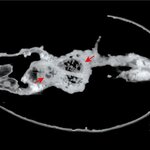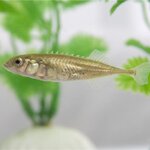Ecology & Zoology

A new monkey has been discovered in a remote region of the Amazon in Brazil, according to the Wildlife Conservation Society (WCS) .
The monkey is related to saddleback tamarins, which include several species of monkeys known for their distinctively marked backs. The newly described distinct subspecies was first seen by scientists on a 2007 expedition into the state of Amazonas in northwestern Brazil.
Researchers have dubbed the monkey Mura's saddleback tamarin (saguinus fuscicollis mura) named after the Mura Indians, the ethnic group of Amerindians of the Purus and Madeira river basins where…

The mystery of a rare bat's unusually large nose has been solved, according to an article in Physical Review Letters.
The adult Bourret's horseshoe bat, known scientifically as the Rhinolophus paradoxolophus meaning paradoxical crest, has a nose roughly 9 millimeters in length but the typical horseshoe bat's nose is half that long, said Rolf Mueller, an associate professor with the Virginia Tech mechanical engineering department and director for the Bio-inspired Technology (BIT) Laboratory in Danville, Va. "This nose is so much larger than anything else," among other bats of the region, he…

Why do some species have parents working together to raise young? In humans, it is the norm but in nature it is rare.
Birds, like humans, have offspring raised by two parents and bird biologists at the University of Bath want to know more about why. The study, published in the Journal of Evolutionary Biology, analyzed more than 50 previous studies of birds to understand why and how they share their parental duties.
Dr Freya Harrison of the Biodiversity lab at the University of Bath, said, "Caring for offspring is essential for their survival in many species…

Ecological Niche Modeling is a great tool for conservation biology, phylogeography and evolutionary biology. However, as Jeff Lozier and colleagues point out in a paper in the Journal of Biogeography that the models are only as good as the data they are based on.
The basic premise of the ENM approach is to predict the occurrence of species on a landscape from georeferenced site locality data and sets of spatially explicit environmental data layers that are assumed to correlate with the species’ range.
This is fine if the researchers themselves collect the data, but many studies rely on…

Renate Matzke-Karasz from Ludwig-Maximilians-Universität Munich has led an international team of scientists who are studying sperm specimens from the London Natural History Museum’s collections. Their research has revealed fossilized evidence for reproduction using giant sperm in a group of small aquatic crustaceans, called ostracods, dating back to 100 million years ago.
The international team analyzed Harbinia micropapillosa specimens from the Cretaceous Period that had remains of the soft body intact. These fossils had been collected, investigated and then donated to the Natural…

You've heard legends of snakes that hypnote their prey - Kaa in "The Jungle Book" did it and Disney is renowned for their scientific accuracy - but a tentacled snake from South East Asia has gone hypnosis one better; it startles its prey so that the fish turn toward the snake's head to flee instead of turning away. In addition, the fish's reaction is so predictable that the snake actually aims its strike at the position where the fish's head will be instead of tracking its actual movement.
"I haven't been able to find reports of any other predators that exhibit a similar ability to influence…

Ok, this is an old story and probably all of you have seen the footage already - but after seeing the video myself, I cannot avoid posting it in my blog too. The recorded ending of a moving story of love between a lion and two young men is still all the rage on YouTube several months after being posted, and if you have not seen it yet, here is your chance to get even.
The story goes as follows -or at least that is what I have read about it. Two Australians, Rendall and Bourke, saw a lion cub for sale at Harrods in 1969, and were moved by the captive creature and bought it. They raised it for…

Humans aren't all that close to each other in a modern sense but in one way we may be a little closer than previously realized: the way fish learn could be closer to humans, suggests a new research study.
A common species of fish which is found across Europe called the nine-spined stickleback could be the first animal shown to exhibit an important human 'social learning' strategy. Sticklebacks can compare the behavior of other sticklebacks with their own experience and make choices that lead to better food supplies, according to the study by St Andrews and Durham universities.
The…

Same-sex behavior has been extensively documented in the non-human animal kingdom, concludes a new review of existing research.
Yep, homosexual behavior is common across species, from worms to frogs to birds - but there's a catch. Same-sex 'behaviors' are not the same across species and researchers may be calling qualitatively different phenomena by the same name. Published June 16 in the journal Trends in Ecology&Evolution, the review by Nathan Bailey and Marlene Zuk, a professor of biology at University of California-Riverside, also finds that although many studies are…

A completely new species has been discovered in the Russian mountains!
Sorry, it's not Bigfoot or Yeti or Abominable Snowman or Bumble or whatever he is called where you are from, though "Bigfoot Found!" on the cover with a big "No" inside would certainly be a strategy worthy of some other science publications.
Instead, it is a much more scientific discovery; a plant root. Professor Hans Cornelissen and his Russian-Dutch team describe this finding in Ecology Letters.
The root belongs to the small alpine plant Corydalis conorhiza and unlike normal roots, which grow…